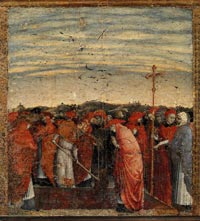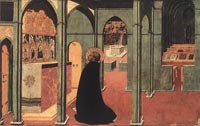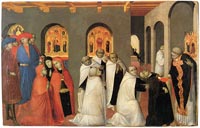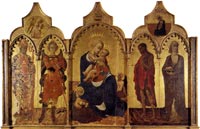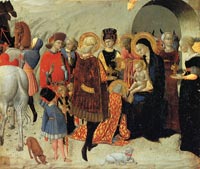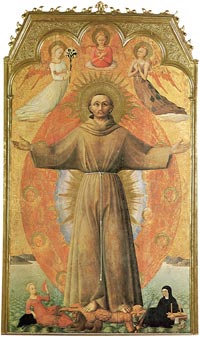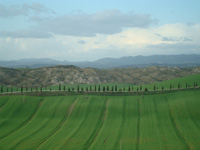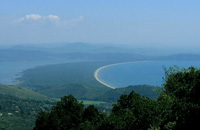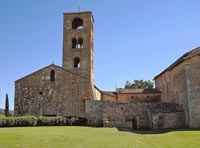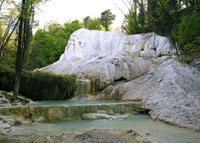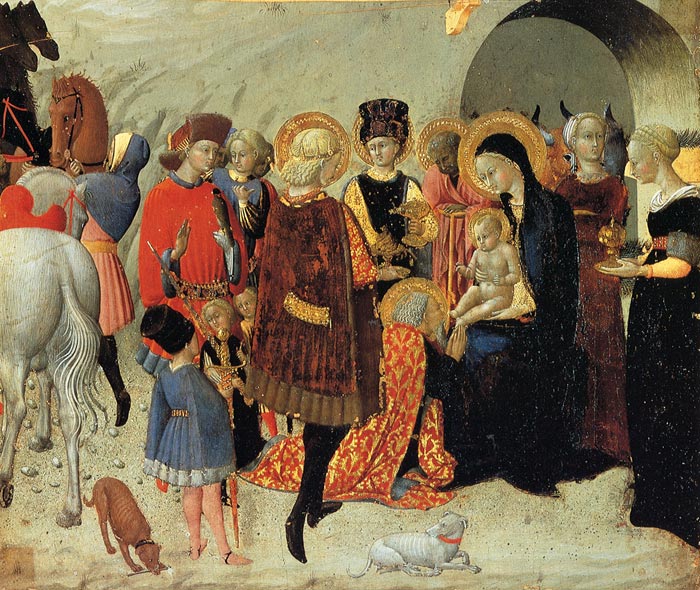 |
|
Sassetta, Adoration of the Magi; about 1435, Siena, Chigi-Saracini Collection (Monte dei Paschi) |
|
Sassetta (Stefano di Giovanni) |
Stefano di Giovanni, known as il Sassetta, (1392 – 1450 or 1451) was born in Siena, although there is also an hypothesis that he was born in Cortona. However, the first historical record of him was in Siena in 1423. Di Giovanni was probably the apprentice of Paolo di Giovanni Fei although it is also thought that he may have studied under Benedetto di Bindo. He painted in the semi-archaic Sienese School style of painting. Francesco di Giorgio e di Lorenzo, better known as Vecchietta, is said to have been his apprentice. |
||
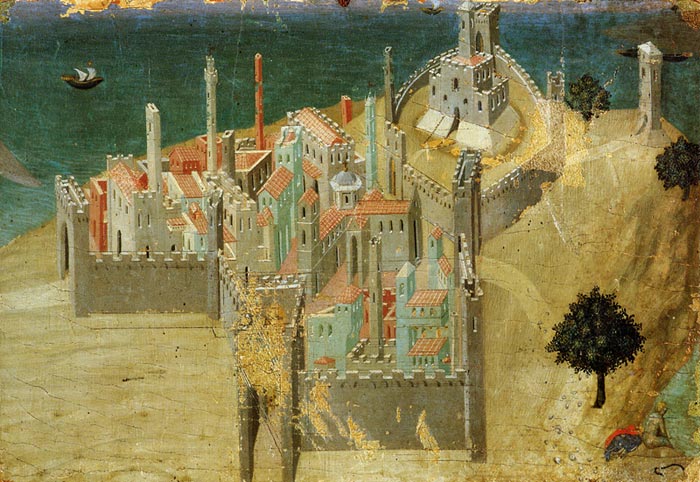 |
||
Sassetta, City by the Sea (view of Talamone), (c.1340), Siena, Pinacoteca, formerly attributed to Ambrogio Lorenzetti |
||
Sassetta's interest in Florentine art is evident in his monumental Madonna of the Snow altarpiece for Siena Cathedral (1430 – 32) and in his most ambitious work, an altarpiece for San Francesco at Sansepolcro (1437 – 44). His fusion of traditional and contemporary elements transformed Sienese painting from the Gothic to the Renaissance style, and he is considered one of the greatest Sienese painters of the 15th century. |
||
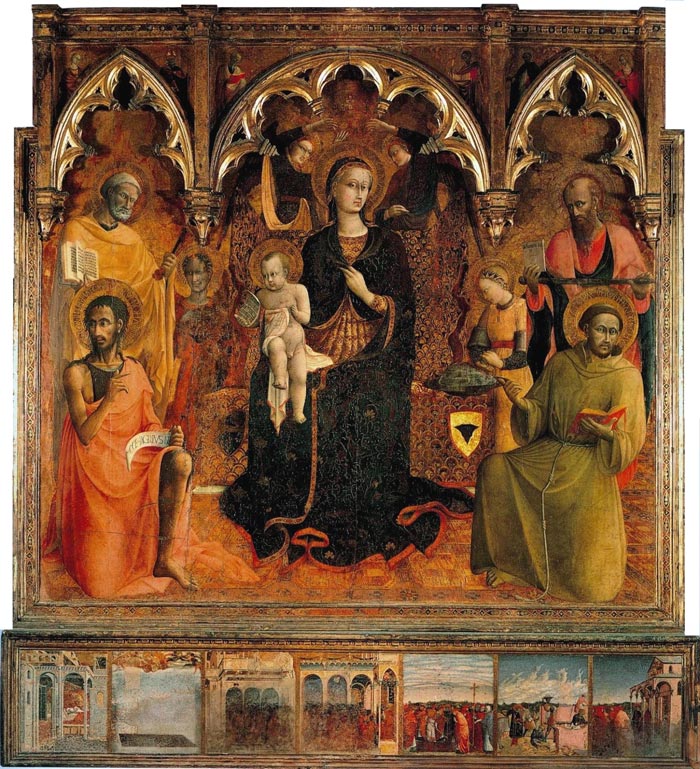 |
||
Sassetta, The Virgin and Child with Saints, 1430-32, Galleria degli Uffizi, Florence |
||
| This altarpiece, known from its subject as the Madonna delle Nevi (the Madonna of the Snows) was originally commissioned for one of the oldest and most venerable altars in the Siena cathedral. It stood immediately left of the doorway known as the Porta del Perdono - the side entrance to the cathedral that provided most immediate access to both the baptistery and to the civic centre of the Palazzo Pubblico and the Campo. Sassetta received the commission in 1430 from Ludovica Bertini, the widow of Turino di Matteo, the man responsible for both the cathedral sacristy and the baptismal font. Sassetta came up with an altarpiece in which a gothic baldachin was combined with an innovative, unified rectangular picture surface, while its construction was based on that of Duccio's doublesided high altarpiece, completed for the same Siena Cathedral in 1311. According to one local chronicler, Turino had died in 1423 and been buried in front of the Porta del Perdono. In the contract for the altarpiece, Ludovica makes it clear that she is commissioning the work both in memory of her husband and also in her own right as a pious Franciscan tertiary, so the coat-of-arms of her own family as well as that of her husband appear prominently displayed on the richly ornamented fabric covering the Virgin's throne. Her commitment to the Franciscan Order is clearly demonstrated by the inclusion of Saint Francis in the right foreground of the main panel of the altarpiece. The imagery chosen for the rest of the altarpiece, however, was entirely Sienese and civic in intention. It depicts the familiar subject of the enthroned Virgin with the Christ Child on her lap and surrounded by angels and saints. The altarpiece therefore echoes the imagery of two of Siena's most revered civic icons - the front face of Duccio's high altarpiece for the cathedral and Simone Martini's mural in the council hall of the Palazzo Pubblico. That such an association was explicitly intended is shown by the inscription engraved on the Virgin's halo: 'If you trust me, Siena, you will be full of favour'. |
||
| The imagery of the altarpiece was elaborated in order to honour two of the Virgin's titles - 'Queen of Heaven' and 'Our Lady of the Snows'. Two angels behind the throne hold a crown over the Virgin's head. The angel on the left of the throne, meanwhile, carries a dish filled with snow and the angel on the right makes a snowball. The seven narrative scenes of the predella describe in detail the legend of Our Lady of the Snows. They show how, in the reign of Pope Liberius (352-66), the Virgin caused snow to fall miraculously in the heat of August on the Esquiline Hill in Rome. Furthermore, the snow fell precisely in the pattern of the ground plan of a church. The Virgin then instructed a wealthy layman and his wife, and Pope Liberius, to build a church in her honour on this site - a church that became Santa Maria Maggiore, one of Rome's major basilicas. Quite unlike the hieratic aura of the main scene, the predella panel recording the miracle of the snow in founding of Santa Maria Maggiore in Rome, is full of naturalistic elements, and even the arrangement and presentation of the figures is casual and almost journalistic. Although the condition of the predella is not as good as that of the main panel, the atmospheric environment created for the outdoor scene is still legible. |
|
|
Arte della Lana Altarpiece (Altar of the Eucharist)
|
||
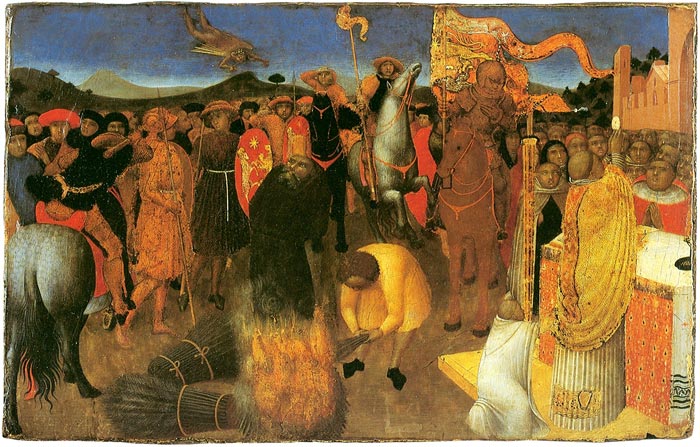 |
||
Sassetta, Death of the Heretic on the Bonfire, 1423, National Gallery of Victoria, Melbourne. The picture shows one of the predella paintings of the Altar of the Eucharist. |
||
| The Arte della Lana Altarpiece, the first known work by Sassetta, was commissioned by the "Arte della Lana", i.e. the woolmerchants' guild for the church of the Carmelite Order in Siena in 1423. Sassetta's Wool Guild altarpiece was an ingeniously movable yet highly elaborate gothic triptych that the guild used for its outdoor celebration of the Feast of Corpus Domini and otherwise stored in its palace. The triptych was dissembled in 1777, and the central panel is lost, but it is possible to reconstruct its original arrangement from earlier descriptions. According to these, the central panel represented the Holy Sacrament in an ostensory adored by a number of angels around it. Above this there was the scene of the Coronation of the Virgin, and on the sides Abbot S. Anthony and S. Thomas Aquinas were depicted. Above these the scene of the Annunciation was represented in two separate pictures. On the predella underneath the main panel, seven small panels showed the following scenes: 1-2. Two scenes from the life of S. Anthony, one of them is about his temptation (Siena, Pinacoteca); 3. Execution of an Heretic on the Bonfire (Melbourne Museum); 4. The Last Supper (Siena, Pinacoteca); 5. The Miracle of the Holy Sacrament (Barnard Castle, Bowes Museum); 6. S. Thomas Aquinas in Prayer in front of the Altar of the Virgin (Budapest, Museum of Fine Arts); 7. S. Thomas Aquinas in Prayer in front of the Crucifix (Vatican, Pinacoteca). Further to the above mentioned ones we know eight panels from the external pillars that represented the Four Doctors of the Church: S. Jerome, Gregory, Ambrose, Augustine as well as the four patron saints of Siena: S. Ansanus, Victor, Savinus and Crescentius. Two small panels from the pinnacles with the figures of the Prophets Elias and Eliseus still exist in the Sienese Picture Gallery. Under the central panel the following inscription was visible: "Hinc opus omne Patres Stefanus construxit ad aras Senensis Johannis agens citra lapsus adultos". The interpretation of this distych is much debated. The iconographic programme of the altar was probably composed by the Carmelite monks. That is why the two prophets, Elias and Eliseus, the "Dux et Pater" and the Pater of the Carmelites were represented on the altar, and in Carmelite habit. We can also see a few Carmelite monks in the pictures of the predella. Sassetta, here shows that he was in touch with all the most recent tendencies of European late-Gothic (which probably came to him by way of the exquisite painting of Masolino da Panicale), while at the same time he went further with the Lorenzetti's intuitions of space, adding realistic features unknown to the previous tradition. Thus, for example, in the St. Antony Beaten by Devils (one of the panels of the above-mentioned predella), the depth and articulation of the landscape is for the first time seen against a blue sky streaked with white clouds, instead of the customary gold background In the Adoration of the Magi in the Chigi Saracini Collection in Siena, a fragment of a larger composition which included the Journey of the Magi in the Griggs Collection in New York, we clearly see that Sassetta was greatly attracted by the art of Gentile da Fabriano, who spent some time in Siena in 1425 and 1426. But it is with the great altar-frontal of the Madonna della Neve, painted in 1430-32 for the Cathedral of Siena and now in the Contini Bonacossi Foundation (Uffizi), that he clearly shows how far he adhered to the "great Florentine concepts of form in perspective" (Graziani), even if these do not have much effect on the composition, but rather tend to stimulate occasional brilliant innovations. Art in Tuscany | Sassetta | Arte della Lana Altarpiece |
||
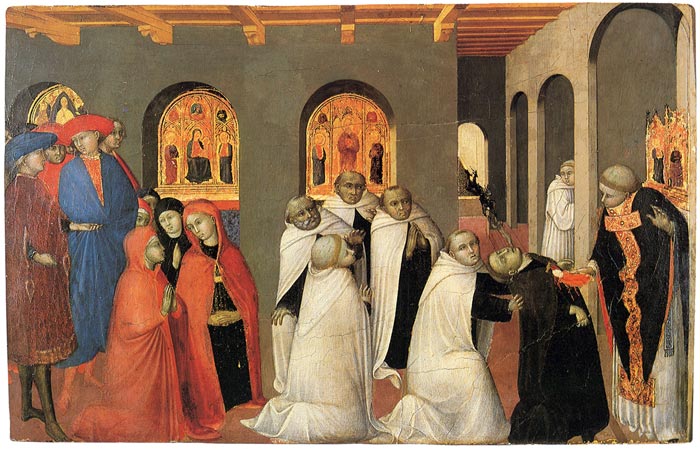 |
||
The small panel, A Miracle of the Sacrament or A Miracle of the Eucharist by Sassetta, painted in Siena c1423-25, has a dramatic tale to tell. It shows a cleric, struck dead as he is offered the Host during Mass. Even more dramatically, a devil swoops down to snatch his soul as it leaves his body. |
||
Virgin with Child and Four Saints |
||
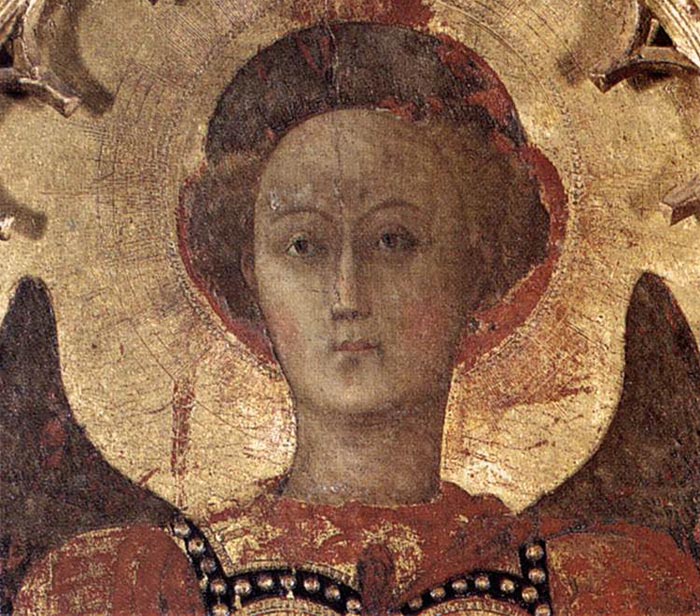 |
||
Sassetta, Virgin with Child and Four Saints (detail, showing the head of St Michael), Museo Diocesano, Cortona |
||
| In the centre of the polyptych there is an exquisite Virgin with Child. On the left side there are Sts Nicholas and Michael, wearing rare, refined, and precious garments. St Nicholas has a chasuble bearing a Pietà. The two saints on the right side are St John the Baptist and St Margaret of Hungary. Above the side panels are two tondi representing the Annunciation. The triptych was placed on a lateral altar in the church of St Dominic in Cortona. At the beginning of the Second World War it was immured in the belfry where the wood suffered much damage due to humidity and temperatures. It was necessary to detach the painted surface and transfer it to a new base. It has been restored after many succeeding interventions. Unfortunately, it has lost its original solidity and need continuous reexamination. |
||
|
||
| Adoration of the Magi, about 1435 |
||
| In the Adoration of the Magi in the Chigi Saracini Collection in Siena, a fragment of a larger composition which included the Journey of the Magi in the Griggs Collection in New York, we clearly see that Sassetta was greatly attracted by the art of Gentile da Fabriano, who spent some time in Siena in 1425 and 1426.[1] |
||
| The Journey of the Magi (fragment), ca. 1435
This panel originally formed the upper part of an Adoration of the Magi, of which the lower section shows the magi presenting their gifts to the Christ Child (Chigi-Saracini Collection, Siena). The fragment shows the magi and their attendants on their way to Bethlehem, and is one of Sassetta's most poetic works. The star at the lower right originally hung over the figures of the Madonna and Child.
|
||
Stefano di Giovanni, The Vision of Saint Thomas Aquinas, 1423-1426. Tempera on wood panel. 25 x 28.8 cm. Picture Gallery. The Vatican. |
||
The Meeting of St. Anthony and St. Paul, 1445, wood, The National Gallery of Art at Washington |
||
| San Sepolcro Altarpiece |
||
 |
||
Sassetta, San Sepolcro Altarpiece, 1437-44, Musée du Louvre, Paris |
||
Echoes of Masaccio and Paolo Uccello can be seen in the great Crucifix painted (probably in 1433) for the church of San Martino in Siena, some fragments of which are in the Chigi Saracini Collection, and in the polyptych of the church of San Domenico at Cortona. These are works that herald the condensed and yet vibrant sculptural precision of this painter's later style. This precision is represented by the great polyptych painted on both sides on which the artist worked from 1437 to 1444 for the Franciscan church of Borgo San Sepolcro, and which was dismembered at the beginning of the last century.
|
||
In 1940 the critic Roberto Longhi realized that it was difficult to find a place in the development of Sassetta's style for the triptych showing the Madonna and Child between St. Jerome and St. Ambrose in the Basilica dell'Osservanza in Siena.
|
||
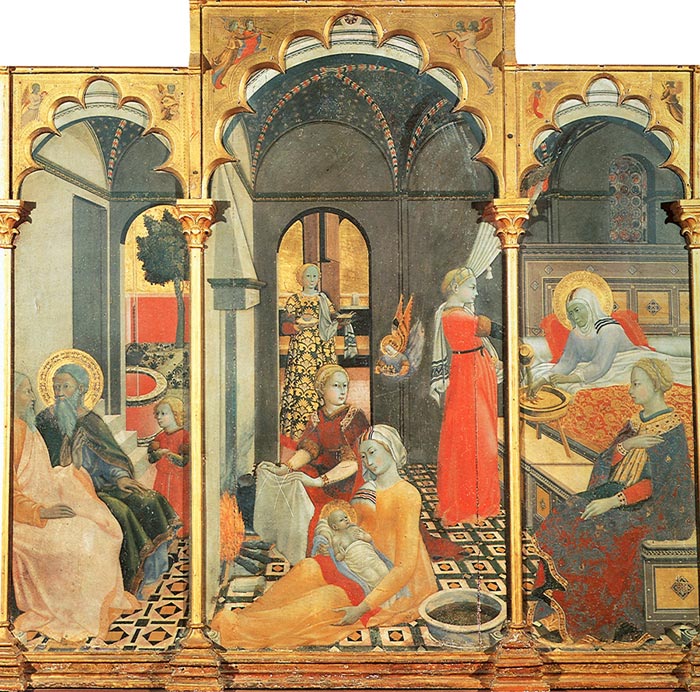 |
||
Master of the Osservanza, Birth of the Virgin with other Scenes from her Life, ca. 1428-39, Museo d'Arte Sacra, Asciano
|
||
Art in Tuscany | Sassetta | San Sepolcro Altarpiece |
||||
E. Carli, Sassetta e il Maestro dell'Osservanza, Milan, 1958.
|
||||
|
||||
Podere Santa Pia |
Val d'Orcia |
|||
 |
||||
Tombolo di Feniglia |
Siena, Duomo
|
|||
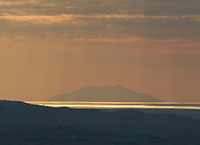 |
||||
Sovicille |
Bagni San Filippo |
Sunsets in Tuscany |
||
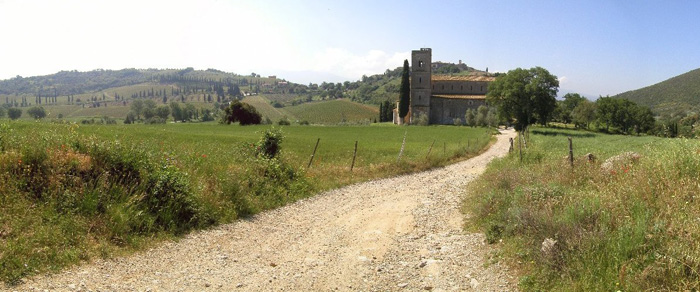 |
||||
Road from Montalcino to Abbadia san't Antimo |
||||
Within easy reach of Podere Santa Pia, 10km south of Montalcino lies the splendid Benedictine abbey church of Sant'Antimo, "Abbazia San't Antimo", in a remarkable position enclosed within low hills. It dates mainly from 1118. The interior is remarkable for its luminous effect, caused by the church having (in part) been built of alabaster. An absolute beautiful, tranquil and picturesque setting !
|
||||
| This page uses material from the Wikipedia article Adoration of the Magi, published under the GNU Free Documentation License. |
||||

